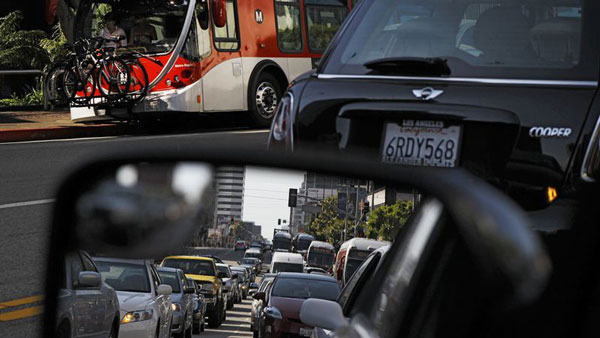[Source: Los Angeles Times] In the movie “Speed,” the inconceivable happens: Sandra Bullock and Keanu Reeves operate a bus during morning rush hour in Los Angeles maintaining a minimum speed of 50 mph. If this feat was implausible when the movie was released 25 years ago, it would be just about impossible today.
Average bus speeds in the Los Angeles metropolitan area have declined by 13.4% since 1994 to a sluggish 12 mph. The Los Angeles Department of Transportation’s DASH buses and Santa Monica’s Big Blue bus have been especially hard hit by congestion over that time period, with speeds declining 34% and 28%, respectively.
Ridership, not surprisingly, has plummeted along with speeds. The ripple effect of both is enormous: More traffic, of course, as people jettison Metro passes for cars; even slower traffic because of more congestion; taxpayer money wasted as transit drivers sit in all that traffic. Most concerning, however, is that slow buses with low occupancy rates are inefficient greenhouse gas emitters that could prevent Los Angeles from doing its part to fight climate change.
Transportation is California’s largest source of climate-changing emissions, accounting for 41% of total greenhouse gases in the state. Meeting the city of L.A.’s voluntary agreement to reduce emissions 50% below 1990 levels by 2025, or California’s state law of 40% reduction in emissions from 2020 to 2030, demands that more people use low-emission mass transit.

There are few means of transportation more energy efficient than a packed bus — and few more wasteful than an empty one. A 60-foot, natural gas-fueled bus needs to average more than eight riders to be more carbon-efficient than those riders driving alone in a car. (Transit agencies that fuel their buses with renewable natural gas captured from landfills and dairy farms instead of oil wells need to average just four passengers.)
The occupancy of Los Angeles-area buses — roughly 4,000 run in L.A. and Orange counties each weekday — has declined from 14.8 passengers in 1994 to 12 passengers in 2017 (the latest complete data). And all signs show it’s still dropping. One of our greatest assets in the fight against climate change is turning into a liability.
Lower, slower ridership is also costing us hundreds of millions of dollars that could be used to improve the system instead of sustaining its inefficiencies.
Transit agencies have to pay drivers for all the time they spend sitting in traffic. Compared to 1994, L.A.-area transit agencies spent an extra $130 million in 2017 to bus drivers, or 7% of their operating budgets.
Los Angeles has to get bus service right to meet climate goals. (Metro has a 40-year-plan to build out rail, but even then most of the county will still primarily be served by buses.) Unfortunately, solutions that would make bus service more rather than less attractive to riders — faster rather than slower — are politically fraught.
Congestion pricing — charging by the car to drive on city streets during the busiest times of day — could alleviate traffic on major boulevards and would have the side-effect of getting buses back up to speed. This, however, is a decidedly unpopular idea. Research by UCLA urban planning professor Michael Manville found that even those who supported raising their sales tax (Measure M) to fund transit were unlikely to support congestion pricing, or even complementary policies like bike lanes.
That leaves bus-only lanes as the best solution for the vicious cycle of declining speeds and ridership — an idea Mayor Eric Garcetti recently joked was only “slightly less controversial than congestion pricing.” L.A.’s mobility plan calls for a 300-mile network of bus-only lanes on city streets by 2035. Garcetti hasn’t backed down from that plan, but he didn’t choose to accelerate the policy as part of his Green New Deal.
In the face of such political inaction, research by the UCLA Institute of Transportation Studies suggests that transit agencies and cities can work together on “tactical” bus-only lanes that can be installed and reversed daily, if necessary.
The first tactical transit lanes appeared in San Francisco in 2014 and have since been put in place in 17 cities across the country. The most effective of them have reduced peak congestion travel times by 20% to 28% , and up to 50% in one case. Such projects are also low-risk politically, as they can be reversed with only a few hours’ notice.
Bus-only lanes, however, even temporary ones, are only as effective as they are exclusive. L.A.’s current street infrastructure, including its peak-hour bus lane on Wilshire Boulevard, is choked with violators. Camera-based enforcement of bus-only lanes is permitted in California, but only in the San Francisco Bay Area; Los Angeles County transit agencies should demand the same authority.
In “Speed,” Reeves’ character saves the day by getting people off the bus. Our task is exactly the opposite. Let’s get it done.
Juan Matute is deputy director of the UCLA Institute of Transportation Studies.
Source: Los Angeles Times
June 18, 2019


